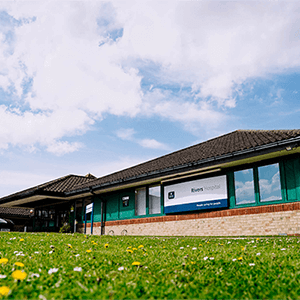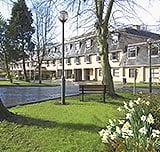
Search by region


A coronary artery bypass graft is surgery to treat coronary artery disease. It allows blood to bypass narrowed or clogged parts of your arteries to improve blood flow to your heart.
CABG does not cure coronary heart disease (CHD) and atherosclerosis. It can ease symptoms, such as chest pain and shortness of breath, improve your heart function and reduce your risk of a heart attack.
During CABG, a healthy artery or vein from another part of your body (usually the chest, leg or arm), known as the graft, is attached to your coronary artery. One end of the graft is placed above the narrowed area or blockage in your artery and the other end below it. Blood then bypasses the blocked or narrowed part of your artery by flowing through your new healthy artery or vein to reach your heart.
You may need more than one graft depending upon the extent of your coronary heart disease and the number of coronary blood vessels that have become narrowed. These are known as a double, triple or quadruple bypass.
CABG is traditionally performed by open-heart surgery where a long cut is made in your chest to access your heart. On-pump coronary bypass surgery uses a heart-lung machine to keep your blood and oxygen flowing through your body. Off-pump or beating-heart surgery does not stop your heart during surgery.
Minimally invasive procedures are also available where your coronary bypass is performed through small cuts in your chest and often uses robotics and video imaging to help your surgeon operate in a small area.
Your surgeon will discuss the options with you in detail.
Coronary artery bypass grafts last around 15 years but this varies from person to person. After that, another intervention, typically stent insertion, is usually required. If stenting is not suitable then another heart bypass may be performed.
As CABG does not cure your CHD, you should look after your heart health by following lifestyle recommendations and taking any prescribed medication.
Open-heart surgery is when your surgeon makes a large cut in your chest to access and repair a fault or damage in your heart. Open-heart surgery can be performed on the muscles, valves, or arteries of your heart.
Heart bypass surgery is traditionally an open-heart surgery, used to treat blocked or narrowed arteries. It involves opening your chest with a large cut, then taking healthy blood vessels from elsewhere in your body and attaching them to a blocked coronary artery so that your blood can bypass the blockage or narrowing.
The recovery process after your coronary artery bypass graft will depend on how it is performed. Also, everyone recovers at different rates.
After open CABG surgery, you will typically spend one to two days in an intensive care unit (ICU) and most people stay in hospital for at least seven days. You will be given information on recovering at home and making lifestyle changes to reduce your risk of heart disease. You should take things easy for a few weeks.
Expect to be able to return to most of your normal activities after about six weeks, including working and driving. Most people make a full recovery within 12 weeks.
You will have a follow-up appointment about six weeks after your operation.
If you have a minimally invasive coronary bypass, you can expect to leave the hospital sooner and have a faster recovery.
You will receive a formal quotation price for your coronary artery bypass graft following your consultation and any required tests with one of our expert cardiothoracic surgeons. This formal quote for your CABG will be valid for 60 days and includes unlimited aftercare.
Ramsay is recognised by all major medical insurers. Coronary artery bypass graft surgery is covered by most medical insurance policies. We advise you to obtain written authorisation from your insurance provider before your CABG.
We have a number of finance options if you are paying for your coronary artery bypass graft surgery yourself. These include:
Coronary Artery Bypass Grafting (CABG) is the most common type of heart surgery for adults performed worldwide.
Ramsay Health Care UK works alongside experienced and skilled cardiothoracic surgeons who perform both open and minimally-invasive coronary artery bypass grafts. They will arrange diagnostic cardiac tests to determine the optimum treatment for your coronary heart disease.
Convenient appointments are available for consultations, diagnostic tests and cardiac surgery without waiting. We understand the difficulty of living with heart disease symptoms and the need to perform treatment as soon as possible to prevent life-threatening cardiac conditions.
Our Ramsay hospitals adhere to strict infection control policies to ensure the safety of our staff and patients when visiting.


At Pinehill Hospital, our dedicated private General Practitioners (GPs) are here to offer you guidance and treatment for chronic migraines.
Clifton Park Hospital, in York, Part of Ramsay Health Care UK, has been shortlisted for the 2026 HSJ partnership award.
Ramsay Health Care UK are celebrating after being named as a Gold National Joint Registry (NJR) Quality Data Provider for the second year running, after successfully completing a national data quality audit programme for 25 hospitals offering orthopaedic procedures.
The information, including but not limited to, text, graphics, images and other material, contained on this website is for educational purposes only and not intended to be a substitute for medical advice, diagnosis or treatment. Always seek the advice of your physician or other qualified health care provider with any questions you may have regarding a medical condition or treatment.
No warranty or guarantee is made that the information contained on this website is complete or accurate in every respect. The testimonials, statements, and opinions presented on our website are applicable to the individuals depicted. Results will vary and may not be representative of the experience of others. Prior patient results are only provided as examples of what may be achievable. Individual results will vary and no guarantee is stated or implied by any photo use or any statement on this website.
Ramsay is a trusted provider of plastic or reconstructive surgery treatments as a part of our wrap-around holistic patient care. Our personal, friendly and professional team are here to support you throughout to ensure the best possible care. All procedures we perform are clinically justified.
*Acceptance is subject to status. Terms and conditions apply. Ramsay Health Care UK Operations Limited is authorised and regulated by the Financial Conduct authority under FRN 702886. Ramsay Healthcare UK Operations is acting as a credit broker to Chrysalis Finance Limited.
Ramsay Health Care UK is not currently recruiting for any roles based outside of England. If you are interested in applying for a role with Ramsay Health Care UK, please note that all available positions are advertised exclusively on our official website: https://www.ramsayhealth.co.uk/careers. Be cautious of individuals or organisations that approach you directly for remotely-based roles. Always verify the authenticity of the job offer and be careful with whom you share your personal information. For more information and advice on employment fraud, please visit: https://www.ramsayhealth.co.uk/careers/recruitment-fraud